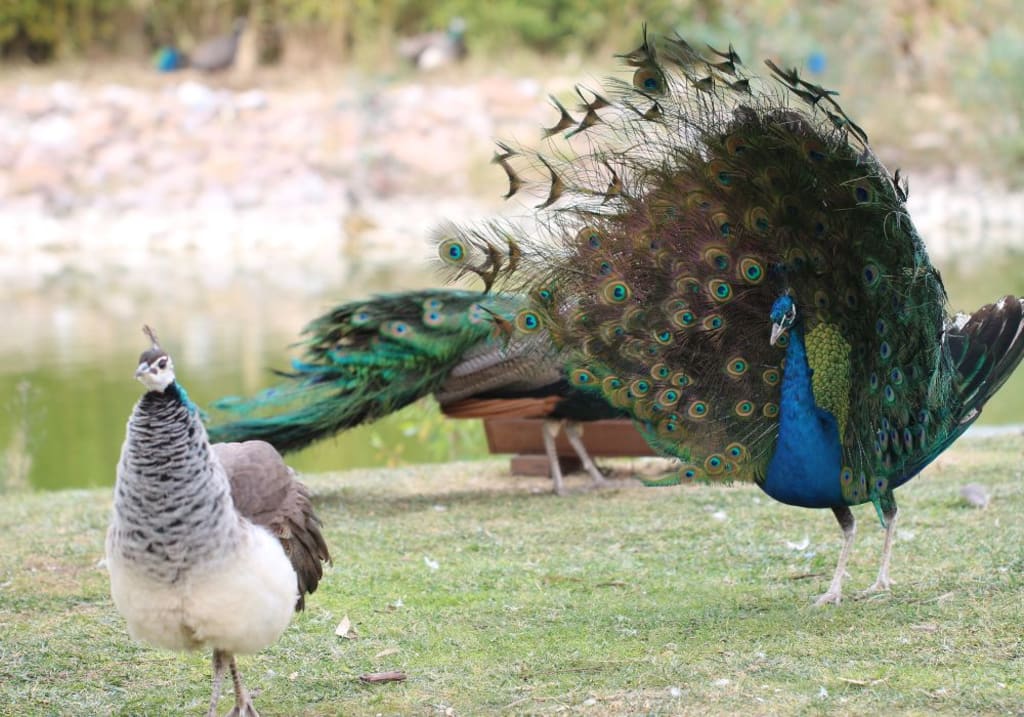Unveiling the Enchanting Differences Between Male and Female Peacocks
Amazing Content

Exploring the Captivating Contrast of Peafowl Genders
Peacocks are nature's most spectacular birds, renowned for their vivid plumage and elaborate displays. But did you know that there's more to these magnificent creatures than meets the eye? The differences between male and female peacocks, or peafowl, go far beyond their striking appearances.
From their physical attributes to their behavioral traits, male and female peacocks exhibit a captivating contrast that has long fascinated birdwatchers and nature enthusiasts alike. In this comprehensive guide, we'll delve into the enchanting world of peafowl, exploring the key distinctions that set these two genders apart.
Plumage and Appearance: The Vibrant Peacock vs. the Subtle Peahen
The most obvious difference between male and female peacocks is their coloration and plumage. Male peacocks, also known as "peacocks," are renowned for their extravagant and iridescent feathers.
These magnificent birds boast a vibrant blue body, accented by a stunning array of eye-like patterns on their long, flowing tail feathers. During the breeding season, male peacocks can fan out their tails in a spectacular display, creating a breathtaking visual that is sure to captivate any onlooker.
In contrast, female peacocks, or "peahens," have a much more subdued appearance. Their plumage typically ranges from shades of brown and grey, helping them blend seamlessly into their natural surroundings.
Peahens lack the ornamental tail feathers of their male counterparts, instead, possessing a shorter, mottled tail that serves a more practical purpose in terms of camouflage and protection.
Size and Stature: The Imposing Peacock and the Petite Peahen
Another striking difference between male and female peacocks is their size and overall stature.
Male peacocks are significantly larger than peahens, with a body length that can reach up to 4.5 feet and a weight of up to 13 pounds. Their most notable feature, however, is their impressive tail feathers, which can extend an additional 5 feet in length, making the total length of a male peacock an astounding 9 feet.
Peahens, on the other hand, are much more petite, measuring around 3.5 feet in length and weighing between 6 to 9 pounds. Their tails are also much shorter, typically ranging from 3 to 6 inches in length. This size difference not only makes the male peacock more visually striking but also plays a crucial role in their courtship and mating behaviors.
Behavioral Differences: Courtship, Territoriality, and Parenting
The behavioral differences between male and female peacocks are just as captivating as their physical attributes.
During the breeding season, male peacocks engage in elaborate courtship displays, fanning out their magnificent tails and shaking them to attract potential mates. This mesmerizing display, accompanied by their loud, far-reaching calls, is a sight to behold.
Females, on the other hand, take on a more passive role, observing these displays and carefully selecting their mates based on the quality and size of the male's plumage.
Male peacocks are also highly territorial, especially during the mating season. They will aggressively defend their territory from other males, using their size, vocalizations, and even physical confrontations to assert their dominance.
Peahens, in contrast, are generally more docile and tend to form small groups or live alone, relying on their camouflage to avoid potential threats.
When it comes to parenting, the roles are clearly defined. Peahens are solely responsible for building nests, incubating the eggs, and caring for the chicks once they hatch. Male peacocks, on the other hand, play no active role in the rearing of their offspring, focusing instead on their own survival and mating rituals.
Dietary Habits and Foraging Techniques
While male and female peacocks share similar dietary preferences, there are some subtle differences in their foraging behaviors.
Both peacocks and peahens primarily feed on a varied diet of insects, small mammals, reptiles, and various plant materials such as seeds and fruits. However, during the breeding season, male peacocks may venture into more open areas to forage, as they need to maintain their impressive plumage and energy levels for their elaborate courtship displays.
In terms of foraging techniques, both genders exhibit similar behaviors, such as scratching the ground with their feet to uncover food. However, the larger size and more dominant nature of male peacocks may sometimes give them an advantage in accessing certain food sources or defending their feeding territories from other individuals.
Vocalization and Communication
Another key difference between male and female peacocks is their vocalizations and communication methods.
Male peacocks are generally more vocal, especially during the mating season. Their calls can be loud and far-reaching, serving to attract females and deter other males from encroaching on their territory.
These calls can range from a distinctive "kee-awk" to a more guttural "meow-like" sound, depending on the context and the bird's emotional state.
Peahens, on the other hand, are generally quieter, but they do communicate with their chicks and other peafowl through more subtle vocalizations and body language. These subtle cues help maintain social cohesion within their small groups and alert them to potential threats or opportunities.
Lifespan and Health Considerations
Both male and female peacocks have a similar average lifespan, typically ranging from 15 to 20 years in the wild. However, their health and longevity can be influenced by various factors, such as environmental conditions, predation, and access to proper nutrition.
Peafowl, regardless of gender, can be susceptible to a range of health issues, including parasitic infections, respiratory diseases, and nutritional deficiencies. Regular veterinary check-ups and a balanced diet are crucial for the well-being of peacocks and peahens, especially those kept in captivity.
Conservation Efforts and Cultural Significance
Peacocks and peahens alike face various threats to their survival, including habitat loss, hunting, and the pet trade. The Green Peafowl, in particular, is listed as an endangered species due to these pressures.
Conservation efforts to protect peafowl populations involve habitat protection, anti-poaching measures, and captive breeding programs to bolster wild populations. These initiatives are crucial in ensuring the long-term survival of these magnificent birds.
Peacocks have also held significant cultural and symbolic importance throughout history. In Hinduism, the peacock is associated with the god Krishna, while in Greek mythology, it is linked to the goddess Hera. Peacock feathers are often used in art and fashion to represent beauty, immortality, and pride.
Peacocks as Pets: Considerations and Challenges
While the beauty of peacocks and peahens can be captivating, keeping them as pets comes with its own set of challenges and considerations.
Peacocks require ample space to roam, a proper diet, and regular veterinary care. Their loud calls and need for social interaction can also be a drawback for some pet owners. Potential owners should carefully research the specific care requirements and be prepared to provide a suitable environment for these unique birds.
Conclusion: Embracing the Enchanting Differences
The differences between male and female peacocks go far beyond their striking appearances. From their physical attributes to their behavioral traits, these captivating birds exhibit a remarkable contrast that has long captivated the human imagination.
Whether you're a birdwatcher, a nature enthusiast, or simply someone who appreciates the beauty of the natural world, exploring the enchanting differences between peacocks and peahens is a journey worth taking. By understanding and appreciating these unique creatures, we can better appreciate the diversity and wonder of the avian world.
About the Creator
Hasan
Welcome...
In this site of mine you can learn amazing things and many information that you don't know so please subscribe to my site.
Enjoyed the story? Support the Creator.
Subscribe for free to receive all their stories in your feed. You could also pledge your support or give them a one-off tip, letting them know you appreciate their work.






Comments
There are no comments for this story
Be the first to respond and start the conversation.